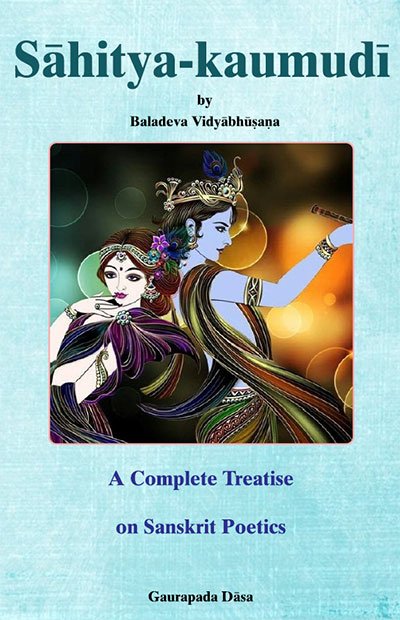Sahitya-kaumudi by Baladeva Vidyabhushana
by Gaurapada Dāsa | 2015 | 234,703 words
Baladeva Vidyabhusana’s Sahitya-kaumudi covers all aspects of poetical theory except the topic of dramaturgy. All the definitions of poetical concepts are taken from Mammata’s Kavya-prakasha, the most authoritative work on Sanskrit poetical rhetoric. Baladeva Vidyabhushana added the eleventh chapter, where he expounds additional ornaments from Visv...
Text 9.25
तारावली वेणु-भुजङ्गमेन
तारावलीला-गरलेन दष्टा |
विषाणिका-नाद-पयो निपीय
विषाणि कामं द्वि-गुणी-चकार ||
tārāvalī veṇu-bhujaṅgamena
tārāvalīlā-garalena daṣṭā |
viṣāṇikā-nāda-payo nipīya
viṣāṇi kāmaṃ dvi-guṇī-cakāra ||
tārāvalī—Tārāvalī; veṇu—[in the form] of the flute; bhujaṅgamena—by the snake; tāra—of a high note; avalīlā—[is in the form] of the play; garalena—[the snake,] whose poison; daṣṭā—[being] bitten; viṣāṇikā—of a small horn; nāda—[in the form] of the sound; payaḥ—milk; nipīya—after drinking; viṣāṇi—the poisons; kāmam—the love; dvi-guṇī-cakāra—doubled.
The gopī named Tārāvalī was bitten by the flute snake, whose poison is the playfulness of a high note. After drinking the milk in the form of the sound of His horn, the poison doubled her passion. (Bhakti-rasāmṛta-sindhu 2.1.374)
Commentary:
The verse features two yamakas. According to Viśvanātha Cakravartī, the underlying idea is the well-known fact that drinking milk aggravates the effect of poison: viṣāṇi dvi-guṇīcakāra, dugdha-pānasya viṣa-vardhakatva-prasiddheḥ (Bhakti-sārapradarśinī 2.1.374). This is prasiddhi-vaiśiṣṭya (the specialty of a well-known fact) (3.3).
